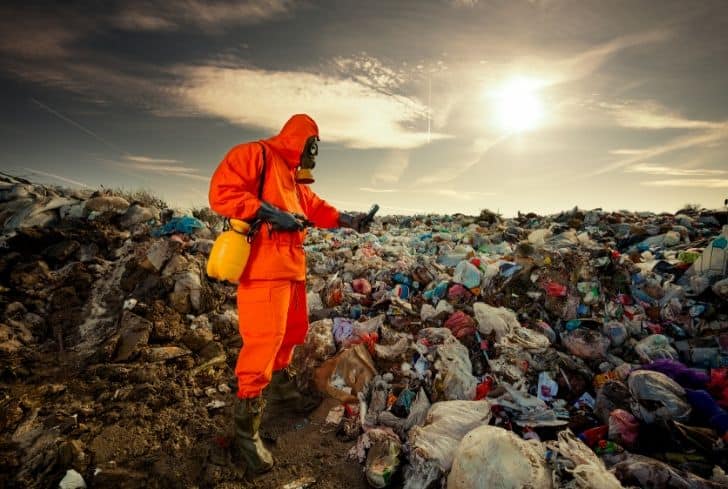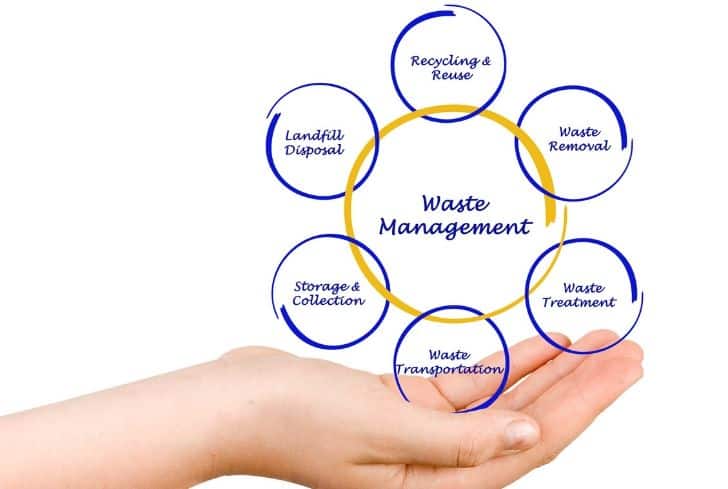Americans alone are responsible for producing a whopping 277 million tons of waste (annually). Since this number is far more than any other nation in the world, the US government and Environmental Associations have devised numerous methods to deal with this burning issue.
But what exactly is Waste Management? In the simplest terms, it can be defined as the collection, transportation, and disposal of garbage, sewage, and other waste products.
The process of waste management involves treating solid and liquid waste. During the treatment, it also offers a variety of solutions for recycling items that aren’t categorized as trash.
The entire idea thus boils down to re-using garbage as a valuable resource and given our current environmental climate, this process is extremely vital for all households and businesses.
According to Wikipedia,
“Waste management or Waste disposal is all the activities and actions required to manage waste from its inception to its final disposal. This includes amongst other things, collection, transport, treatment and disposal of waste together with monitoring and regulation. It also encompasses the legal and regulatory framework that relates to waste management encompassing guidance on recycling etc.“
You will find there are eight major groups of waste management methods, each of them divided into numerous categories. Those groups include source reduction and reuse, animal feeding, recycling, composting, fermentation, landfills, incineration, and land application.
You can start using many techniques right at home, like reduction and reuse, which works to reduce the amount of disposable material used.
The Benefits of Waste Management
There are multiple benefits to treating and managing waste. In this section, we will take a closer look at them.
Better Environment
Probably the biggest advantage of managing waste is that it eventually leads to a better and fresher environment.
Waste disposal units also contribute to the well-being of people by helping them become disease-free. The best part: all of this happens while the unnecessary is duly disposed of in a proper and sanitary manner.
Multiple waste disposal units should be placed in tier-1 and tier-2 cities in a bid to prep up the process of waste disposal. This will also help implement remarkable safety measures in the long run.
Reduces Pollution
When waste is managed the right way, it doesn’t merely eliminate the subsequent waste but also reduces the impact and the intensity of harmful greenhouse gases like carbon-di-oxide, carbon mono-oxide, and methane that are often exuded from accumulated wastes in landfills.
Managing waste reduces our reliance on landfills while also significantly cutting down the many factors that adversely impact our environment.
Conserves Energy
Recycling is one of the biggest aspects of waste management, and over time, it helps conserve energy. One of the biggest instances of this advantage can be traced to the practice of recycling paper.
All of us are probably aware that thousands of trees are cut to produce paper. When a used paper is recycled to create new paper, the need of cutting trees is significantly minimized. This helps conserve energy while also reducing your carbon footprints.
Creates Employment
The recycling industry alone creates hundreds of jobs. As more people adopt this eco-friendly practice, organizations creating and selling recycled products come to the forefront. This helps boost their business while also creating hundreds of jobs.
Helps Make a Difference
By managing waste, you are also making a difference to the society and the world in general. While none of us can completely get rid of garbage, we can always adopt eco-friendly practices of reducing and reusing waste. This way, you create an example for the people around you, who in turn are now motivated to embrace a sustainable approach.
There are eight major categories of waste management, and each of them can be divided into numerous sub-categories.
The categories include source reduction and reuse, animal feeding, recycling, composting, fermentation, landfills, incineration, and land application. Some of these methods like reduction and reuse can be started from the comfort of your homes.
Various Methods of Waste Disposal
Although there are many methods of disposing of waste, in this section let’s take a look at some of the most commonly used methods that you should know about waste management.
Landfills
Throwing daily waste/garbage in the landfills is the most popularly used method of waste disposal used today. This process of waste disposal focuses attention on burying the waste in the land. Landfills are commonly found in developing countries.
There is a process used that eliminates the odors and dangers of waste before it is placed into the ground.
While it is true this is the most popular form of waste disposal, it is certainly far from the only procedure and one that may also bring with it an assortment of space.
This method is becoming less these days although, thanks to the lack of space available and the strong presence of methane and other landfill gases, both of which can cause numerous contamination problems.
Landfills give rise to air and water pollution which severely affects the environment and can prove fatal to the lives of humans and animals. Many areas are reconsidering the use of landfills.
Incineration/Combustion
Incineration or combustion is a type disposal method in which municipal solid wastes are burned at high temperatures. The process eventually converts them into residues and gaseous products.
The biggest advantage of this type of method is that it can reduce the volume of solid waste to 20 to 30 percent of the original volume. Additionally, it also decreases the space they take up while also reducing the stress on landfills.
Incinerators are primarily used in thermal treatment where solid waste materials are converted to heat, gas, steam, and ash. Incineration is also widely popular in countries where landfill space is no longer available, such as the US and Japan.
Recovery and Recycling
Resource recovery is the process of taking useful discarded items for a specific next use. These discarded items are then processed to extract or recover materials and resources or convert them to energy in the form of useable heat, electricity or fuel.
Recycling is the process of converting waste products into new products to prevent energy usage and consumption of fresh raw materials. Recycling is the third component of Reduce, Reuse and Recycle waste hierarchy.
The idea behind recycling is to reduce energy usage, reduce the volume of landfills, reduce air and water pollution, reduce greenhouse gas emissions, and preserve natural resources for future use.
Plasma gasification
Plasma gasification is another form of waste management. Plasma is primarily an electrically charged or highly ionized gas. Lighting is one type of plasma that produces temperatures that exceed 12,600 °F.
With this method of waste disposal, a vessel uses characteristic plasma torches operating at +10,000 °F which is creating a gasification zone till 3,000 °F for the conversion of solid or liquid wastes into a syngas.
During the treatment of solid waste by plasma gasification, the waste’s molecular bonds are broken down as a result of the intense heat in the vessels and the elemental components.
Thanks to this process, the destruction of waste and dangerous materials are found. This form of waste disposal provides renewable energy and an assortment of other fantastic benefits.
Composting
Composting is an easy and natural bio-degradation process that takes organic wastes i.e. remains of plants and garden and kitchen waste and turns into nutrient-rich food for your plants.
Composting, normally used for organic farming, occurs by allowing organic materials to sit in one place for months until microbes decompose it.
Note that composting is often deemed to be one of the best methods of waste disposal as it can turn unsafe organic products into safe compost. The process, however, has its downsides. Some people have found it to be slow, while others have observed that it takes a lot of space.
But regardless of these issues, many people are still embracing home composting approaches to manage and reduce waste.
Waste to Energy (Recover Energy)
Waste-to-Energy, also widely recognized by its acronym WtE is the generation of energy in the form of heat or electricity from waste.
Waste to energy(WtE) process involves the conversion of non-recyclable waste items into useable heat, electricity, or fuel through a variety of processes. This type of so energy is a renewable energy source as non-recyclable waste can be used over and over again to create it.
WtE can also help reduce carbon emissions by offsetting the need for energy from fossil sources. Over time, this reduces global warming and makes our environment better.
Special Waste Disposal
There are certain waste types that are considered hazardous and cannot be disposed of without special handling which will prevent contamination from occurring.
Biomedical waste is one example of such a waste disposal method. It is primarily practiced in health care facilities and similar institutions. The special waste disposal system effectively disposes of hazardous biomedical waste.
Avoidance/Waste Minimization
The most easier method of waste management is to reduce the creation of waste materials thereby reducing the amount of waste going to landfills.
Waste reduction can be done through recycling old materials like jar, bags, repairing broken items instead of buying a new one, avoiding the use of disposable products like plastic bags, reusing second-hand items, and buying items that use less designing.
The Best Methods of Waste Management
Recycling and composting are a couple of the best methods of waste management. Composting is so far only possible on a small scale, either by private individuals or in areas where waste can be mixed with farming soil or used for landscaping purposes.
Recycling, on the other hand, can be widely used around the world, with plastic, paper, and metal leading the list of the most recyclable items. Most material recycled is reused for its original purpose. In some instances, they may also be sold for generating profits.
Bottom Line
As you can see there are plenty of important things that you should know about waste management and disposal in order to ensure that you and the environment around you are safe.
While it may not be apparent, it is your choice that paves the way towards a better world and a healthier environment. That is why always be sustainable and make actionable efforts to manage and treat waste.
Since we have listed multiple waste management methods, explore your options, before making a final choice.
References:







